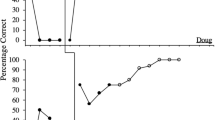Abstract
Recent data suggest that individuals with autism show deficits in social cognitive abilities when compared with nonautistic persons matched for mental age. These deficits have been proposed as a basis for the social interaction difficulties seen in autistic persons. In the present study, autistic youth were compared with a matched group of nonautistic mentally retarded youth on three role-taking tasks and three measures of social competence. Results indicated that the autistic group was relatively deficient on each of the social competence measures and on one of the role-taking measures. The role-taking measure on which the groups differed also correlated significantly with each of the social competence measures. Results were discussed in terms of the interplay between social cognitive abilities and social interaction.
Similar content being viewed by others
References
American Psychiatric Association (1980).Diagnostic and statistical manual of mental disorders (3rd ed.). Washington, DC: Author.
Baron-Cohen, S., Leslie, A. M., & Firth, U. (1985). Does the autistic child have a “theory of mind”?Cognition, 21, 37–46.
Baron-Cohen, S., Leslie, A. M., & Firth, U. (1986). Mechanical, behavioural and intentional understanding of picture stories in autistic children.British Journal of Developmental Psychology.
Chandler, M. J., Greenspan, S., & Barenboim, C. (1974). Assessment and training of role-taking and referential communication skills in institutionalized emotionally disturbed children.Developmental Psychology, 10, 546–553.
Damasio, A. R., & Maurer, R. G. (1978). A neurological model for childhood autism.Archives of Neurology, 3577–786.
DeVries, R. (1970). The development of role-taking as reflected by the behavior of bright, average, and retarded children in a social guessing game.Child Development, 41, 759–770.
Fein, D., Pennington, B., Markowitz, P., Braverman, M., & Waterhouse, L. (1986). Toward a neuropsychological model of infantile autism: Are the social deficits primary?Journal of the American Academy of Child Psychiatry, 25, 198–212.
Ferster, C. B. (1961). Positive reinforcement and behavioral deficits of autistic children.Child Development, 32, 437–456.
Gratch, G. (1964). Response alternation in children: A developmental study of orientations to uncertainty.Vita Humana, 7, 49–60.
Gresham, F. M. (1986). Conceptual and definitional issues in the assessment of children's social skills: Implications for classification and training.Journal of Clinical Child Psychology, 15, 3–15.
Hermelin, B., & O'Connor, N. (1970).Psychological experiments with autistic children. Oxford: Pergamon.
Higgins, E. T. (1981). Role taking and social judgement: alternative developmental perspectives and processes. In J. H. Flavell & L. Ross (Eds.),Social cognitive development: Frontiers and possible futures (pp. 119–153). Cambridge: Cambridge University Press.
Hobson, R. P. (1982). The autistic child's concept of persons. In D. Park (Ed.),Proceedings of the 1981 International Conference on Autism, Boston, USA. Washington, DC: National Society for Chidren and Adults with Autism.
Kanner, L. (1943). Autistic disturbances of affective contact.Nervous Child, 2, 217–250.
Langdell, T. (1978). Recognition of faces: An approach to the study of autism.Journal of Child Psychology and Psychiatry, 19, 255–268.
Lovaas, O. I., Koegel, R. L., & Schreibman, L. (1979). Stimulus overselectivity in autism: A review of research.Psychological Bulletin, 86, 1236–1254.
Lovaas, O. I., Schreibman, L., Koegel, R., & Rehm, R. (1971). Selective responding by autistic children to multiple sensory input.Journal of Abnormal Psychology, 77, 211–222.
Lowe, M. R., & Cautela, J. R. (1978). A self-report measure of social skills.Behavior Therapy, 9, 535–544.
Matson, J. L., Helsel, W. J., Bellack, A. S., & Senatore, V. (1983). Development of a rating scale to assess social skill deficits in mentally retarded adults.Applied Research in Mental Retardation, 4, 399–407.
Ollendick, T. H. (1981). Assessment of social interaction skills in school children.Behavioral Counseling Quarterly, 1, 227–243.
Ornitz, E. M., & Ritvo, E. R. (1968). Perceptual inconstancy in early infantile autism.Archives of General Psychiatry, 18, 76–98.
Rimland, B. (1964).Infantile autism. New York: Appleton-Century-Croft.
Ritvo, E. R., & Freeman, B. J. (1978). National society for autistic children definition of the syndrome of autism.Journal of Autism and Childhood Schizophrenia, 8, 162–167.
Rutter, M. (1968). Concepts of autism: A review of research.Journal of Child Psychiatry, 9, 1–5.
Rutter, M. (1983). Cognitive deficits in the pathogenesis of autism.Journal of Child Psychology and Psychiatry, 24, 513–531.
Schopler, E., Reichler, R. J., Devellis, R. F., & Daly, K. (1980). Toward objective classification of childhood autism: Childhood autism rating scale (CARS).Journal of Autism and Developmental Disorders, 10, 91–103.
Sigman, M., & Ungerer, J. A. (1981).Social behaviors in autistic children. Paper presented at Society for Research in Child Development, Boston.
Sparrow, S. S., Balla, D. A., & Cicchetti, D. V. (1984).Vineland Adaptive Behavior Scales. Circle Pines, MN: American Guidance Service.
Tinbergen, E. A., & Tinbergen, N. (1976). The aetiology of childhood autism: A criticism of the Tinbergens' theory: A rejoinder.Psychological Medicine, 6, 545–550.
Author information
Authors and Affiliations
Rights and permissions
About this article
Cite this article
Oswald, D.P., Ollendick, T.H. Role taking and social competence in autism and mental retardation. J Autism Dev Disord 19, 119–127 (1989). https://doi.org/10.1007/BF02212723
Issue Date:
DOI: https://doi.org/10.1007/BF02212723




